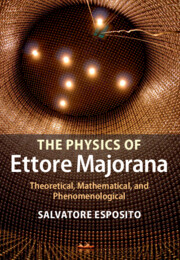Book contents
- Frontmatter
- Contents
- Acknowledgments
- Part I Introducing the character
- Part II Atomic physics
- Part III Nuclear and statistical physics
- Part IV Relativistic fields and group theory
- Part V Quantum field theory
- Part VI Fundamental theories and other topics
- Part VII Beyond Majorana
- 14 Majorana and condensed matter physics
- 15 Majorana neutrinos and other Majorana particles: theory and experiment
- Appendix Molecular bonding in quantum mechanics
- References
- Author index
- Subject index
15 - Majorana neutrinos and other Majorana particles: theory and experiment
Published online by Cambridge University Press: 18 December 2014
- Frontmatter
- Contents
- Acknowledgments
- Part I Introducing the character
- Part II Atomic physics
- Part III Nuclear and statistical physics
- Part IV Relativistic fields and group theory
- Part V Quantum field theory
- Part VI Fundamental theories and other topics
- Part VII Beyond Majorana
- 14 Majorana and condensed matter physics
- 15 Majorana neutrinos and other Majorana particles: theory and experiment
- Appendix Molecular bonding in quantum mechanics
- References
- Author index
- Subject index
Summary
What are Majorana particles? They are massive fermions that are their own antiparticles. In this chapter we will concentrate on spin-1/2 Majorana particles, though fermions of higher spin can also be of Majorana nature. Obviously, Majorana particles must be genuinely neutral, i.e. they cannot possess any conserved charge-like quantum number that would allow one to discriminate between the particle and its antiparticle. In particular, they must be electrically neutral. Among the known spin-1/2 particles, only neutrinos can be of Majorana nature. Another known quasi-stable neutral fermion, the neutron, has non-zero magnetic moment, which disqualifies it from being a Majorana particle: the antineutron exists, and its magnetic moment is opposite to that of the neutron.
Neutrinos are exactly massless in the original version of the Standard Model of electroweak interaction [314], and are massive Majorana particles in most of its extensions. Although massive Dirac neutrinos are also a possibility, most economical and natural models of neutrino mass lead to Majorana neutrinos. Since only massive neutrinos can oscillate, interest in the possibility of neutrinos being Majorana particles rose significantly after the first hints of neutrino oscillations obtained in solar and atmospheric neutrino experiments. This interest increased greatly after the oscillations were firmly established in the experiments with solar, atmospheric, accelerator, and reactor neutrinos [394, 395, 396]. In addition to being the simplest and most economical possibility, Majorana neutrinos have two important added bonuses: they can explain the smallness of the neutrino mass in a very natural way through the so-called seesaw mechanism, and they can account for the observed baryon asymmetry of the Universe through “baryogenesis via leptogenesis.” We shall discuss both here.
In the limit of vanishingly small mass, the difference between Dirac and Majorana fermions disappears. Therefore the observed smallness of the neutrino mass makes it very difficult to discriminate between different types of massive neutrinos, and it is not currently known if neutrinos are Majorana or Dirac particles. The most promising means of finding this out is through the experiments on neutrinoless double β-decay. Such experiments are currently being conducted in a number of laboratories.
- Type
- Chapter
- Information
- The Physics of Ettore MajoranaTheoretical, Mathematical, and Phenomenological, pp. 303 - 353Publisher: Cambridge University PressPrint publication year: 2014
- 4
- Cited by



